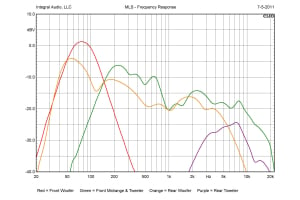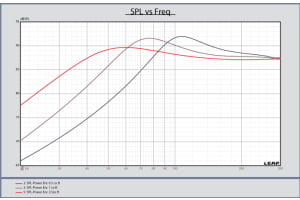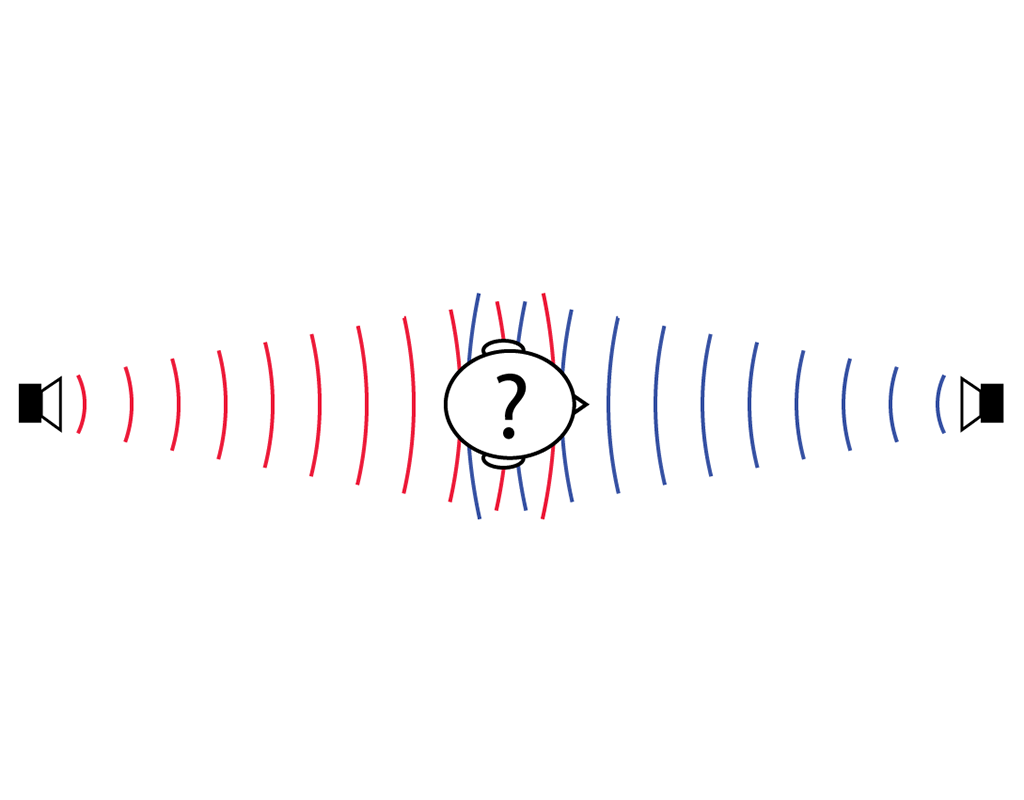
The Effects of Redundant Channels on Stereo Reproduction in a Vehicle Cabin
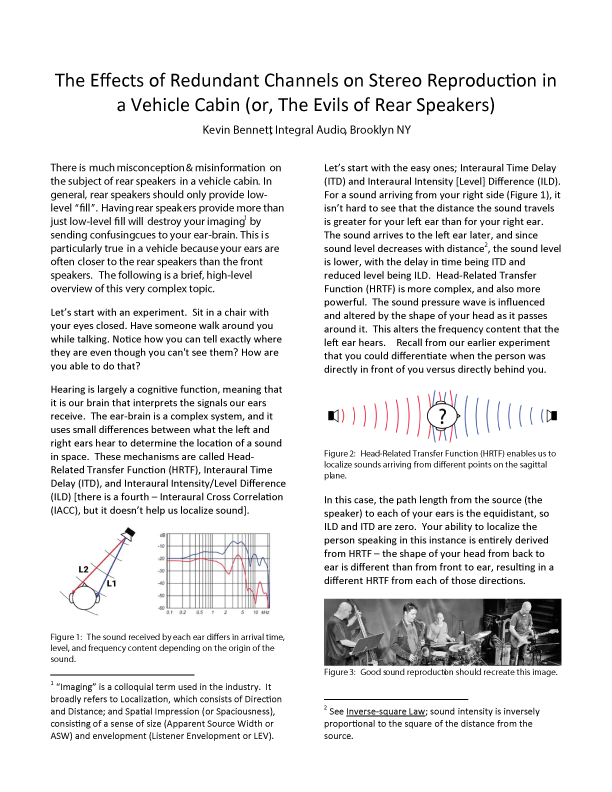
Note: This post is adapted from a white paper originally written by Kevin Bennett.
There is much misconception & misinformation on the subject of rear speakers in a vehicle cabin. In general, rear speakers should only provide low-level “fill”. Having rear speakers provide more than just low-level fill will destroy your imaging by sending confusing cues to your ear-brain.
This is particularly true in a vehicle because your ears are often closer to the rear speakers than the front speakers. The following is a brief, high-level overview of this very complex topic.
Let’s start with an experiment. Sit in a chair with your eyes closed. Have someone walk around you while talking. Notice how you can tell exactly where they are even though you can't see them? How are you able to do that?
These mechanisms are called Head-Related Transfer Function (HRTF), Interaural Time Delay (ITD), and Interaural Intensity/Level Difference (ILD) [there is a fourth – Interaural Cross Correlation (IACC), but it doesn’t help us localize sound].

Let’s start with the easy ones; Interaural Time Delay (ITD) and Interaural Intensity [Level] Difference (ILD). For a sound arriving from your right side (Figure 1), it isn’t hard to see that the distance the sound travels is greater for your left ear than for your right ear. The sound arrives in the left ear later, and since sound level decreases with distance, the sound level is lower, with the delay in time being ITD and reduced level being ILD.
Head-Related Transfer Function (HRTF) is more complex, and also more powerful. The sound pressure wave is influenced and altered by the shape of your head as it passes around it. This alters the frequency content that the left ear hears.
Recall from our earlier experiment that you could differentiate when the person was directly in front of you versus directly behind you. In this case, the path length from the source (the speaker) to each of your ears is

Your ability to localize the person speaking in this instance is entirely derived from HRTF – the shape of your head from back to
Now imagine you are at a small concert venue listening to your
A major goal of proper sound reproduction is to replicate this experience, and if you’ve enjoyed good, high-end home audio you know that this is achievable.
Of course, reproducing music requires recording it. Each of those musicians instruments radiates multi-directional sound, creating a

The recording process involves capturing, as much as possible, this three dimensional sound field with a large number of microphones, and then blending and mixing this information down to just two channels – left and right - for stereo recordings.
The hypothetical microphones on the left side of Figure 3 would pick up more direct and early reflected sound from the bass player, and these will correspondingly be of higher volume in the left channel of the mixed recording.
Microphones on the right side would pick up direct sound from the guitar, but also time-delayed, lower-volume direct sound and reflections from the bass player, and these would be mixed into the right channel in the recording. The saxophone and drums in the center will be more balanced over both left and right channel, and so on.
So, stereo recordings are mixed and intended to be reproduced on two channels. Adding rear speakers in a car makes four channels, with the rears exactly duplicating the fronts (there is no “rear” channel in stereo, only left and front). This means that a sound that should be coming only from the front left channel is now also coming from behind you, and arriving at a different time and from a different direction.
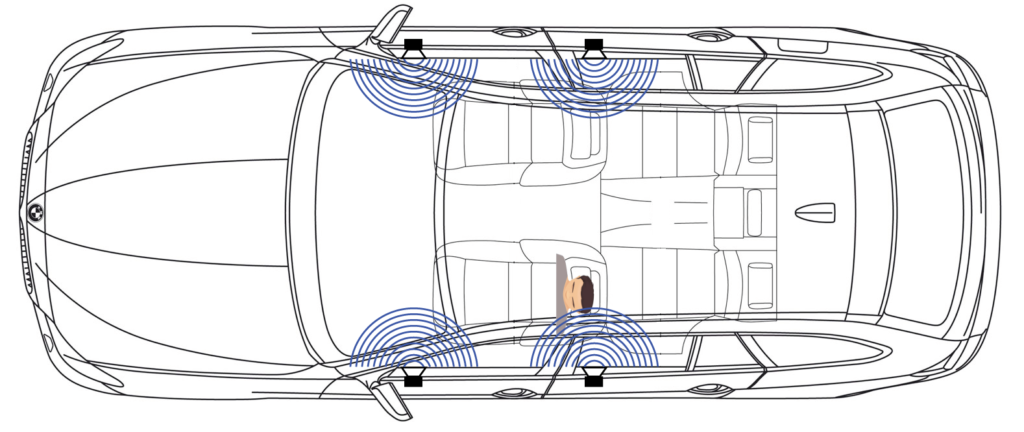
Even worse, in many modern
Figure 5 shows data on the audibility and localization of sounds arriving from different directions based in part on research done by Haas (1972), Toole (2006), and others. If
Two ears and a brain can't figure out how to integrate the same sound arriving from both front and rear with confusing timing, and you lose the ability to locate where the sound should be in space - no more imaging!
Why have the rears at all you ask, given the above? Decades of research has shown that we like the sense of feeling “enveloped” by sound. If properly
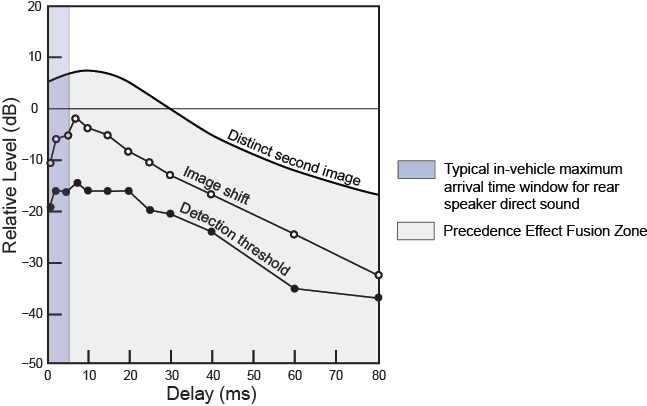
The key is to provide sound from the rears in a manner that contributes to listener envelopment without damaging our sense of imaging. In a general sense, you can think of properly configured rear speakers as substituting for the reflections you would get in a more normal listening room that you do not get in a vehicle.
Figure 6 is based on research by Barron (1971), Toole (2009), and many others. Combining the information from Figures 5 & 6 it is apparent that rear speakers should deliver sounds to the front passengers at a reduced volume level (-10dB to -20dB), with reduced

If you do not have the ability to delay in time or to reduce
In our Soundstage™ systems, we use the above principles when incorporating the rear speakers (and center speaker, if present) into the design. Though each system design is unique, in most cases the rear (and center) speakers are not replaced, but levels and frequency content are reduced or altered to achieve the desired results of providing only rear-fill.
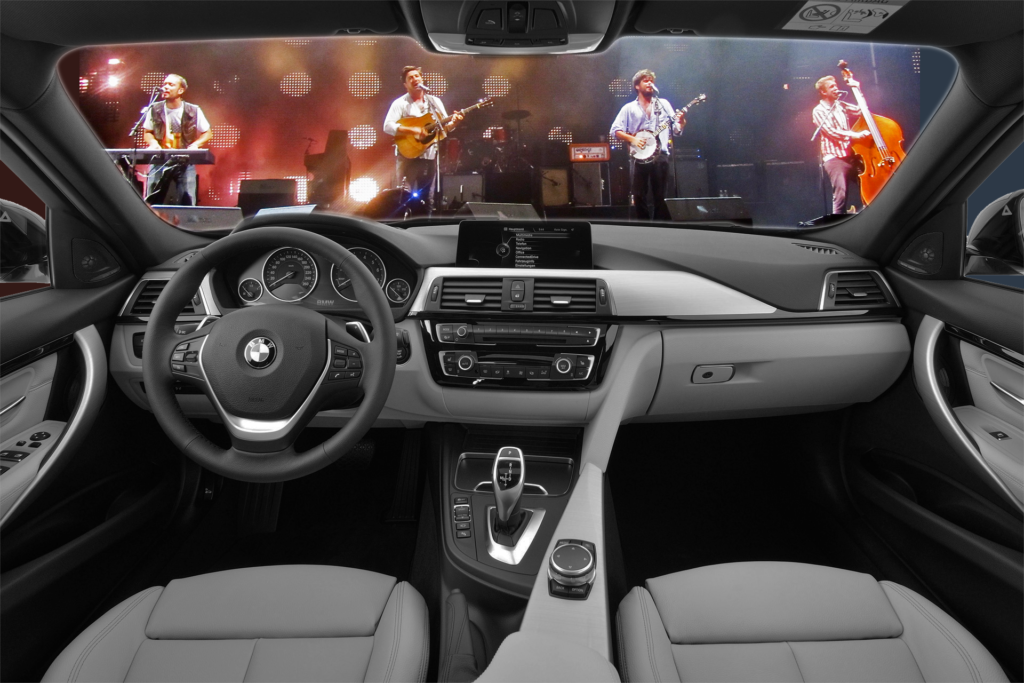
Given the minimal relative levels required for rear-fill the cost and trouble of replacing them would far outweigh the very small benefit. When done correctly, the results are extremely enjoyable!


